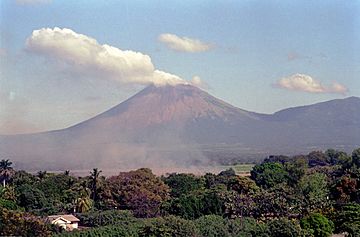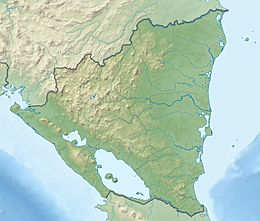San Cristóbal Volcano facts for kids
Quick facts for kids San Cristóbal |
|
|---|---|

San Cristóbal from the Ingenio San Antonio sugar mill in Chichigalpa, Nicaragua
|
|
| Highest point | |
| Elevation | 1,745 m (5,725 ft) |
| Geography | |
| Location | Chinandega Department, Nicaragua |
| Parent range | Cordillera Los Maribios |
| Geology | |
| Mountain type | Stratovolcano |
| Last eruption | March 2021 |
Volcán San Cristóbal is the tallest volcano in Nicaragua. It stands at 1,745 meters (5,725 feet) high. This impressive volcano is located in the northwest part of the country. It forms a beautiful background for the city of Chichigalpa, in the Chinandega area. San Cristóbal is also one of the most active volcanoes in Nicaragua.
San Cristóbal is part of a group of five volcanoes. This group is called the San Cristóbal volcanic complex. Chonco volcano is about 4 kilometers (2.5 miles) to the west. Moyotepe is 4 kilometers (2.5 miles) to the northeast. Another volcano, Volcán Casitas, is connected to San Cristóbal's eastern side. In 1998, Casitas caused a huge landslide that covered a village. You can still see the marks from that landslide today. Finally, La Pelona is at the eastern end of this volcanic group.
Physical Features of San Cristóbal
San Cristóbal is the newest volcano in its complex. It has a classic cone shape, which is typical for a stratovolcano. Its sides are almost perfectly even. The southwest side is the longest slope. The crater rim on that side is 140 meters (460 feet) higher than the northeast side. This difference is because strong winds blow volcanic ash and rock to the southwest.
The crater at the top of the volcano is large, measuring about 500 by 600 meters (1,640 by 1,970 feet). The volcano was once covered in thick tropical forests. However, it constantly releases a lot of gas and smoke. This constant activity has unfortunately killed off much of the plant life around the crater.
History of Eruptions
San Cristóbal has a long history of eruptions. Here are some of its notable activities:
- 1685: The volcano erupted very strongly. This event was important enough to be written down in history books.
- August 1919: It made loud noises and caused small tremors. People in nearby areas could feel these tremors.
- May 1971: The volcano produced loud bangs and explosions.
- March 1976: It sent up a tall, steady column of smoke. There were also several small tremors and explosions every three minutes.
- December 1986: The volcano released a lot of gases.
- January 1987: It continued to expel large amounts of gas.
- May 1997: A new period of eruptions began. The volcano released gases, ash, and sand. It also caused light tremors.
- December 1999: Gas, ash, and sand were expelled again.
- May, August 2001: The volcano became active once more.
- April 2006: A moderate phreatic eruption occurred. This type of eruption happens when hot magma heats water, creating steam.
- July 2008: The volcano rumbled with a series of small explosions. It also released gas.
- September 2009: There was an explosion and a moderate amount of ash was expelled.
- September 2012: Three large explosions happened. The volcano sent gas, ash, and sand up to 5,000 meters (16,400 feet) into the air. This happened after an earthquake in Costa Rica.
- December 25, 2012, into 2013: The volcano showed increased seismic activity. It had multiple eruptions over the next few days.
- April 11, 2014: A plume of gas, possibly containing ash, drifted about 20 kilometers (12 miles) to the west.
- July 20, 2014: Two explosions occurred in the afternoon. They produced small plumes of ash that rose 100 meters (330 feet).
- March 9, 2021: There was a moderate expulsion of ash. This ash affected the nearby town of Chinandega.
Current Activity
San Cristóbal is still very active today. It constantly releases large amounts of gas and smoke. As recently as September 2009, ash was reported falling in nearby towns. In September 2012, it erupted again. It spewed ash up to four kilometers (2.5 miles) into the atmosphere. This led to about 3,000 people in the surrounding area being evacuated for safety.
Another eruption started on December 25, 2012. It continued into 2013, causing hundreds of local residents to be evacuated.
On Wednesday, March 10, 2021, the volcano had an eruption. It sent ash about 10,000 feet (3,000 meters) into the air. This ash covered several towns in the area.
See also
 In Spanish: Volcán San Cristóbal para niños
In Spanish: Volcán San Cristóbal para niños
- List of volcanoes in Nicaragua



